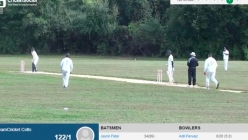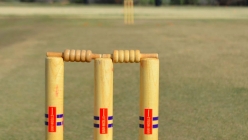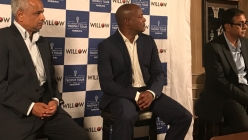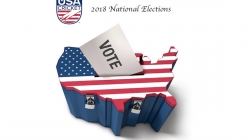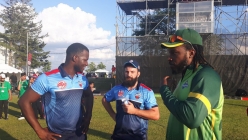USA Cricket: In a league of their own!
2011 Mar 19 by DreamCricket USA
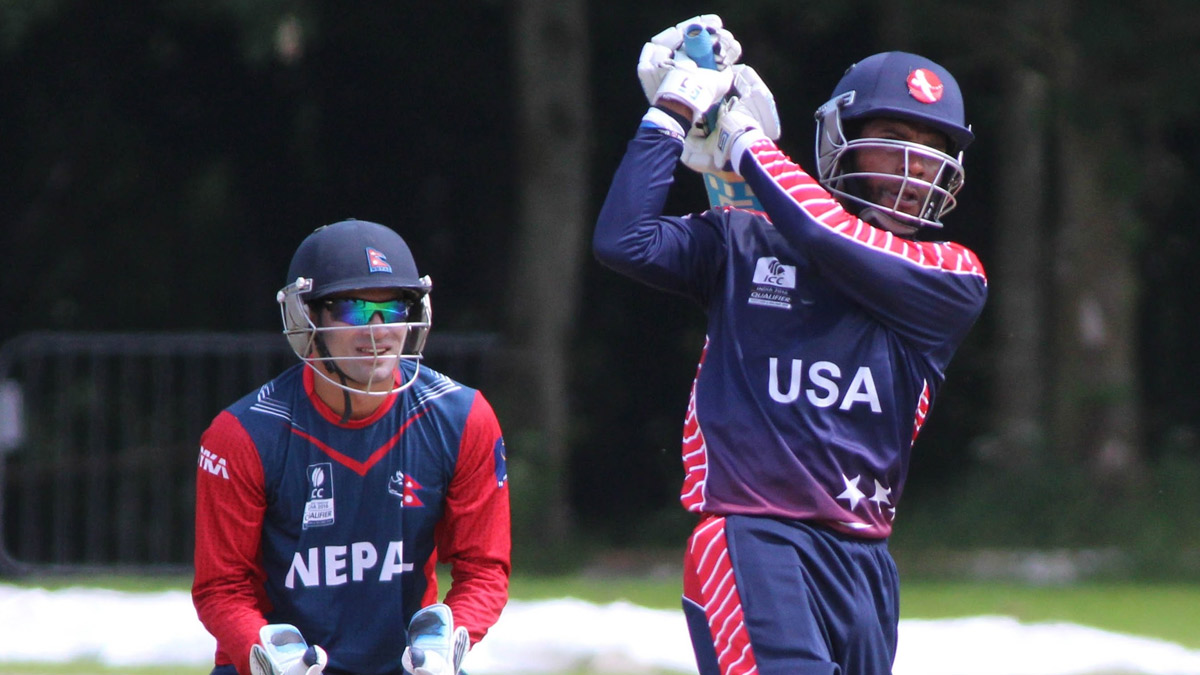
Ensuring that all free persons are proportionately represented is something that even the founding fathers of America had to guarantee, which is why congressional house seats are apportioned by counting the whole number of persons.
Now, you can get all the USA Cricket updates via Facebook. Also follow us on Twitter via @dreamcricket
By Venu Palaparthi
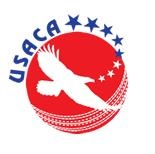 In a 2009 editorial column on the right to vote, I wrote: "Not having proportionate voting poses several issues for USACA such as fragmentation and lack of cohesion."
In a 2009 editorial column on the right to vote, I wrote: "Not having proportionate voting poses several issues for USACA such as fragmentation and lack of cohesion."
"Ensuring that all free persons are proportionately represented is something that even the founding fathers of America had to guarantee, which is why congressional house seats are apportioned by counting the whole number of persons."
The ongoing drama in the NW and SW regions has me convinced that the question of franchise remains one of the most contentious issues facing USA cricket today. And I have no doubt that this topic is going to consume a lot of bandwidth, especially with the coming elections for regional and national boards.
Deconstructing the vote
For starters, the USACA grants a vote to full member leagues that are in good standing. Deconstructing that sentence, in order to be able to vote, a league should have had at least eight (8) clubs or teams, each club or team comprising at least fifteen (15) players who play according to a published schedule, and the cricket is played in accordance with the Laws of Cricket established by MCC and Playing Conditions established by ICC.
By this definition, a wide variety of leagues such as indoor cricket leagues, taped ball leagues, heavy tennis ball leagues, sixes leagues, etc., are not entitled to a vote because they do not play according to the Laws of Cricket. The constitution rightly offers these types of leagues an opportunity to become associate members, not full members.
Most outdoor hard ball leagues with eight or more clubs are eligible to become full members, provided they meet two additional requirements. Firstly, the league should be approved by USACA as a full member, which means it should have undergone a period of one year as a provisional league. And secondly, the constitution has provisions for financial eligibility and good standing, which we will come to in just a bit.
The spirit of the rules
In spirit, if not in letter, when the constitution says 'pursuant to a schedule' the constitution expects the eight clubs to participate in the same league competition. And in spirit, if not in letter, there is an expectation that each club or team comprises 15 unique individuals.
As an illustration, a league may have a T20 contest with four participating teams and a separate 40-over competition with four reconstituted teams comprising the same individuals. This does not become a 8-club league just because, based on the optics, it looks like it has 8 teams.
The other thing the constitution does not touch upon is age-group cricket. Trying to apply the definition of a league to age-group cricket is like trying to place a square peg in a round hole. As an illustration, if a junior league conducts an U-13 competition, an U-15 competition and an U-17 competition, and each competition comprises 3 teams, does it qualify as a full-member league with 9 teams? Let me make that more interesting. What if 50% of the boys in the U-17 teams also participate in U-15 competitions since they are below 15 years of age?
Not only does this pose a mathematical challenge, it also leads to the philosophical quetion of whether youth cricket leagues should be sheltered from the political arena. I have argued in the past and I still maintain that youth cricket could use a lot less politics and a greater degree of involvement and mentoring by the clubs and leagues. However, the current reality is that the entire junior cricket system - from tryouts to the playing eleven - is infused with conflict.
In other cricketing nations, youth activities are an integral part of regular club-level and league-level activities, so the system, while not exactly conflict-free, works differently. In USA, given the dismal track record of involvement in junior cricket by clubs, leagues or even regions, I am not at all surprised to see junior cricket programs and academies staking out more direct claims by wanting to become full-member leagues. However, I do not endorse these claims. [For the record, four junior cricket organizations, including DreamCricket Academy, remain associate members with no voting privileges.]
A list of leagues
I recently met with an individual who told me he was contemplating a run for the USACA board. We discussed the challenges and opportunities facing USACA and he seemed to have a well thought-out plan for resolving some of the most challenging issues. But he had a more immediate and tactical problem - he was struggling to find an authoritative list of leagues that are voting-eligible.
After the meeting, I embarked on an exercise to identify the voting-eligible leagues. The list of USACA members in the 'Regional Administrations' section of USACA.org provides a starting point. According to this list, there are 44 USACA full-member leagues in USA (excluding Michigan Cricket Association, which, in case you are wondering, is listed as an Associate Member).
At first glance, this list appears to be incomplete. At the very minimum, it does not list many associate members including DreamCricket Academy. The list also does not include at least one other league in my region. And there might well be other such inconsistencies. At the risk of repeating, the aforementioned list could be rendered more useful.
Good standing
The 'Summary of Leagues and Clubs paid through December 31, 2010' document lists the leagues, whether associate or full-member, that have not yet paid their dues for 2010.
According to this list, nine (9) leagues have not yet paid their membership dues for 2010. The nine leagues are - Cricket League of New Jersey, Garden State Cricket League, Millenium Cricket League, Indoor Cricket USA, ICMCL, National Cricket League, United Cricket Conference, New York Cricket League and the Mid-Atlantic Cricket Conference.
Per the constitution, these leagues could have their membership terminated "due to non-payment of membership of fees, dues, fines, assessments or penalty which remains unpaid by the stipulated date." To an emailed query on whether the board had stipulated a date or established a penalty for delinquent leagues, John Thickett, the USACA Treasurer replied: "No late payment penalties were established by the Board in 2010. Whether someone can pay a late payment penalty now, also pay for 2010, and remain in good standing is up to the Board."
I know for certain that some of these leagues have every intention to pay their past dues and zero intention of losing their membership. I have also spoken to representatives of two leagues and they told me that it was just an oversight! Well, the leagues need to clean up their act and be aware of the consequences.
It would have helped everyone involved, including the cash-strapped USACA, if a reminder was posted on USACA website ahead of the payment deadline. CLNJ alone had 46 clubs and might have contributed $4,600 to USACA's coffers when that money was most needed. I am not suggesting that USACA was obligated to do this, but I think it is a good practice. Even my municipality sends out a reminder for the taxes it collects.
Bogus leagues
We like to think cricket is special because we have 'laws' instead of rules. The unfortunate reality is that there are those that follow the law, and there are those that don't. Just as matches can be won by fixing, it appears that leagues too can be fixed.
Earlier this year, I received an email from a league administrator who wrote to inform me that he and a few others had broken away from his previous league to form a new association. While on the topic, he noted with anguish that there were several 'bogus' leagues in his region. "Everybody in my region knows which ones these are," he wrote. I requested him to do us all a favor and name the 'bogus' leagues for the record. He replied that he did not want to put his newly formed league "at risk" by challenging the administrators of his region - a tacit admission that the regional administrators cannot be expected to be fair.
Interestingly, a quick review of the USACA Paid Club Numbers by League list reveals that 10 of the 48 leagues i.e. roughly 20% of the leagues had the exact magic total of eight (8) clubs. I have heard that some underdeclare (to save the $100 per club fees) and some overdeclare (likely for voting privileges). Of course, I have no doubt at all that a few of these 8-club leagues are bona fide.
I spoke to the league administrators of two such leagues which currently enjoy full-member status. One told me that he knows he does not qualify as a full member league. The other confessed that his league had not played any matches in 2010! These gentlemen know who they are! One of them told me that he applied to become an associate league but was granted the rights of a full-member. He told me that he does not plan to vacate his seat at the board because he wants to contribute meaningfully to his region. I don't doubt him at all because I know first-hand that he is among the more energetic contributors to cricket in the region. But driving licenses are not given out to persons just because they are good, can drive and are of driving age. There are other systemic requirements that must be met. And if you don't agree with those requirements, then the right thing to do is to fix the system.
That brings us to the issue at hand - how do we guarantee proportionate representation. How do we give a voice to the organizations that want to contribute to the region and to USACA.
Give clubs the vote
My proposal is to give each unique club a vote. The clubs must designate the leagues they are affiliated to. If they choose, they should be allowed to grant proxies to a delegate. Each club getting the vote should undergo proper due diligence. This due diligence should be thorough and should help to identify potential duplication. Each club must be required to disclose their members, all of whom become card-carrying individual members of USACA. This is not rocket-science.
Under this proposed framework, an academy will have a vote if it plays as a club within a larger league. In addition to cleansing the system of bogus leagues, it will also expand USACA's reach. Take a hypothetical league in Hawaii, just as an example. Let us assume that the league has four highly motivated clubs. Why not collect dues from the four clubs and offer them voting privileges? Especially if these clubs are doing their bit to promote cricket in an area that USACA presently has no presence in? Do they not deserve proportional representation in their region's affairs? Don't you think the region will be motivated to get involved in that territory if the clubs had a say in their region's affairs?
I know of at least four active leagues in my region that have not joined USACA. Their clubs are in far-flung corners of the Atlantic Region - from Pittsburg, PA to Wilmington, DE. I think the proposed format will be sufficient motivation for these leagues to opt in. And even if the leagues themselves opt out, some of their component clubs may join as associates.
In summary, under the proposed approach, there is a greater chance that the non-affiliated organizations that currently opt out, the associate leagues that do not have the required number of clubs, and qualifying academies, all will become part of the overall national fabric.
Size matters!
Of course, granting votes to clubs eliminates the forced voting parity between a league that has 30 clubs and one that is an 8-club league.
The 'size-doesn't-matter' policy has led to undesirable side-effects with the larger leagues feeling left out of important decisions that affect the region. In some cases, an unhealthy adversarial relationship has developed between the larger and smaller leagues. I have heard horror stories about leagues that have tried to get a ground for themselves by bad-mouthing a rival league. I am not making any of this up! This is the present day reality.
The current structure does not reward organizations that are cohesive and work towards gaining greater influence. Quite the contrary, I have spoken to two league administrators who said they have considered breaking up their large league into a federation of smaller leagues for greater political influence.
Since we are on this topic, I think we should also do away with the 3-league minimum requirement for qualification as a region. This rule is somewhat arbitrary. Divisions based on quality of cricket or geographic separation are justified - we see them in every cricket playing nation. But I see no reason for having a league for league's sake. Among the many undesirable side-effects, I have noticed that this leads to regions having inter-league tournaments among unequals.
Card Carrying Members
Late last year, I spoke to two cricketers who live in Bentonville, Arkansas, which is the home of Walmart. One of them had played first class cricket for Tamil Nadu until 2005 and the other played first class cricket for both Mumbai and Surrey in the 90's. Both are experienced coaches, in fact, one of them has been a development coach for a very famous team, which shall be unnamed.
The two gentlemen were keen on getting involved with cricket in USA.
Following my conversations, it occurred to me that there was currently no path for these two extremely qualified cricketers to become card-carrying members of USACA.
USACA membership is presently only open to organizations "with a verifiable membership base of at least fifteen (15) members." We are asking these two gentlemen to join the nearest competitive full-member league in Dallas, TX, some 350 miles away! The alternative approach is for these two former first-class cricketers to join the local recreational league (yes there is such a league, and it has 8 teams), then persuade that league to join USACA!
If the former TN player is not part of a club that is part of a member league of his CW region, how is he ever going to know the dates for a regional try-out?
Don't you think USACA could open its doors a bit wider?
[Full disclosure: The author is a founder of DreamCricket.com, and by extension, DreamCricket Academy. Since August of 2010, the author has represented CLNJ on the board of the Atlantic Region. CLNJ is the region's largest member league. Opinions expressed here are those of the author and do not necessarily reflect the positions of these organizations.]
